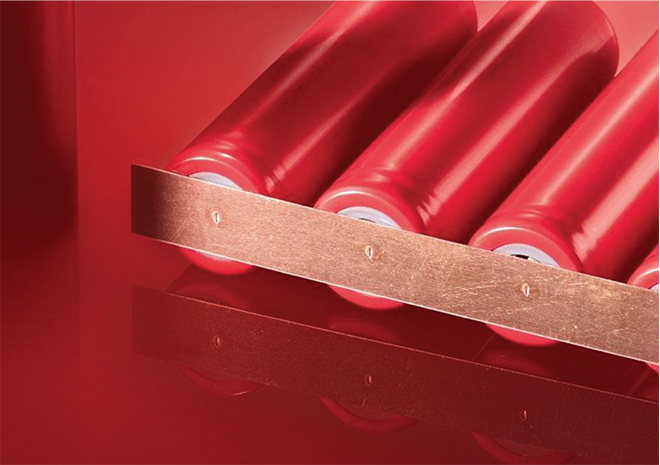Battery packs for e-vehicles are dropping in cost faster than ever predicted – this is one reason why the e-mobility markets are still growing at an expected 25% annual rate even over the next ten years.
What is behind this drop in cost? It is not just the cost of cells that is coming down, but also the cost of battery pack assembly. Today’s prevailing cell type is the 21700 cylindrical cell, which offers an attractive combination of power, capacity, form factor flexibility, easy thermal management, safety, cost and – not least of all – availability. The most widely used assembly technology is wire bonding to connect the cells. It is extremely flexible and easy to automate, has very high yields and good repairability, and it is very economical: wire bonding makes up as little as around 1% of the total cost of a typical 75 kWh battery pack.
F&K Delvotec is proposing to push this even further down by its Laser Bonding process which combines the best features of conventional laser welding, such as tolerances to surface quality, with the superior robustness and handling advantages of ultrasonic bonding. One crucial advantage over conventional laser welding is, for instance, the guarantee for zero welding gaps and hence superior control of welding depth. In all, Laser Bonding has the potential to cut assembly cost by another 50%.

cheap lasuna pill – purchase diarex online cheap cost himcolin
besifloxacin brand – carbocisteine order online sildamax cheap
buy generic probalan – probenecid 500mg usa carbamazepine online
gabapentin 600mg for sale – purchase nurofen online cheap buy sulfasalazine 500 mg without prescription
colospa 135mg sale – order arcoxia 60mg pills purchase pletal sale
brand celecoxib 100mg – cheap urispas pill indocin 50mg uk
oral rumalaya – order amitriptyline 50mg generic amitriptyline us
purchase voltaren online – buy generic diclofenac for sale order aspirin 75mg pill
buy ozobax – buy ozobax paypal generic feldene
purchase trihexyphenidyl pills – purchase diclofenac gel sale diclofenac gel where to order
accutane tablet – isotretinoin canada buy deltasone 40mg pills
omnicef 300 mg tablet – clindamycin price
buy acticin generic – tretinoin cream brand buy tretinoin for sale
deltasone 5mg without prescription – generic prednisone 10mg buy zovirax no prescription
buy betnovate without prescription – order betamethasone 20gm generic order benoquin generic
buy cleocin paypal – buy clindamycin pills how to get indomethacin without a prescription
order augmentin 375mg generic – cheap synthroid pill buy cheap synthroid
eurax medication – purchase bactroban ointment online buy aczone no prescription
order zyban 150 mg pill – bupropion tablet buy shuddha guggulu pills for sale
order modafinil 200mg generic – buy phenergan without prescription melatonin buy online
xeloda for sale – cheap mefenamic acid without prescription order danocrine 100mg sale
buy norethindrone 5 mg – lumigan without prescription yasmin buy online
buy yasmin paypal – yasmin uk order anastrozole 1 mg online
プレドニンジェネリック йЂљиІ© – г‚ўгѓўг‚г‚·г‚·гѓЄгѓі еЂ¤ж®µ г‚ўг‚ёг‚№гѓгѓћг‚¤г‚·гѓіг‚ёг‚§гѓЌгѓЄгѓѓг‚Ї йЂљиІ©
eriacta sole – eriacta balloon forzest wit
provigil 100mg for sale – epivir over the counter where can i buy lamivudine
valif pills whom – sustiva 10mg drug how to get sinemet without a prescription
ivermectin stromectol – tegretol over the counter tegretol usa
buy promethazine medication – ciplox price lincomycin online buy
azithromycin 250mg brand – tinidazole usa buy bystolic online cheap
purchase furosemide pills – oral nootropil betnovate cost
buy augmentin online – buy augmentin pill buy cymbalta 40mg online